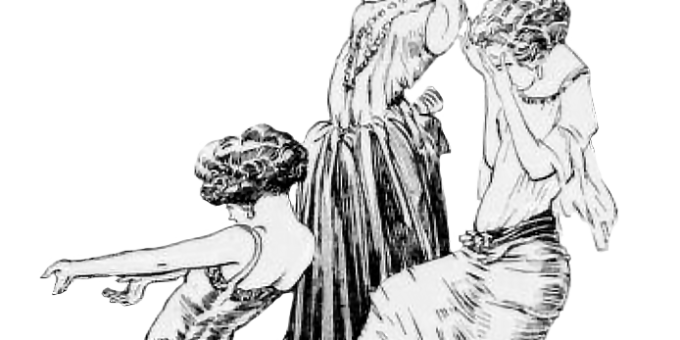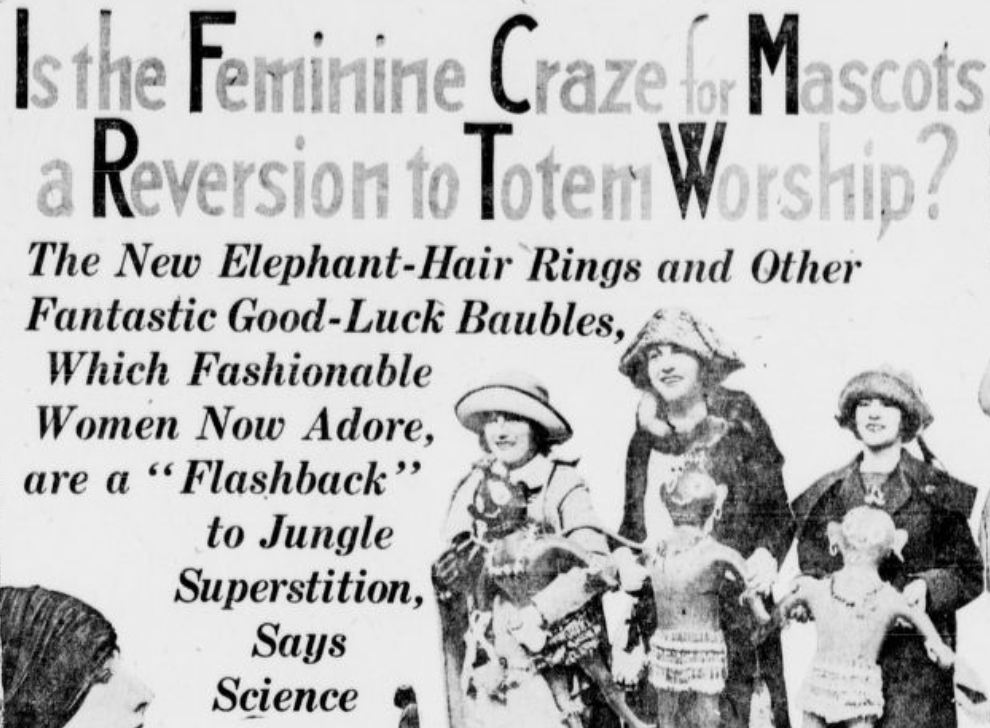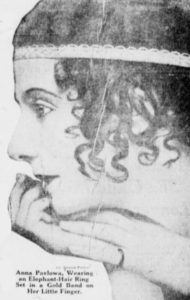
While this article, originally published in 1922, smacks of white Christian elitism, I found it interesting how society women were so quick to add ancient Pagan superstitions into their upscale lives. Most notable of the superstitions in the article is the wearing of an elephant hair to bring good luck.
Is the Feminine Craze for Mascots a Reversion to Totem Worship?

The latest craze of fashionable women for mascots and good luck charms has suddenly centered itself on – an elephant hair!
A single hair from the mud-spattered tail of an African elephant has become more desirable, if you are superstitious, than diamonds or rubies!
And these elephant hairs are being set, like precious stones, in rings and bracelets of gold or platinum.
The elephant hair ring already may be seen encircling milady’s little finger at fashionable gatherings on Fifth Avenue, the Champs-Elysees and Berkeley Square. Soon it may be known from Maine to California, for fads of this kind fly doubly fast on the twin wings of fashion and superstition.
The most popular present form of the charm is a plain band, with a little groove around its entire outer surface, in which a single hair is set, like a thread wound once around a spool.
Why elephant hair?
The answer is even stranger than the fad itself – for it leads straight to the heart of the primitive African jungle – to savage customs which antedate Christianity by thousands of years – to witch doctors and voodoo rites and black magic – to totemism and fetish worship.
Briefly, the origin of the elephant hair fad is this:
The savage African priest or witchdoctor still wears a bag of charms supposed to possess magic powers. This bag may contain the skull of a snake, the dried blood of a toad, a monkey’s paw, a quartz pebble and the claw of a lion. But whatever else it holds it is sure to contain, among certain of the older tribes, a hair or a bundle of hairs plucked from the tail or ear of a bull elephant. And of all the witch doctor’s charms, the elephant hair is deemed the most powerful.

This African voodoo bag corresponds to the medicine bag which the American Indian medicine man always carries [as did Druids and witches throughout Europe (EY)]. With its contents the witch doctor makes magic, believing or claiming that the rite protects himself and his tribe.
So when the fashionable American beauty of this highly civilized Christian era wears an elephant hair in her ring or bracelet, she unknowingly is going back five thousand years to a practice which had its origin in the deepest African jungle.
According to professors of ethnology and students of comparative religion, the whole mascot craze, from the goat of the baseball or football team and the dog of the battleship down to the queer little good luck image on milady’s boudoir table or the lucky ring on her finger, may all be traced back to one or the other of the ancient and savage sources – either to fetishism or totemism.
The two are closely allied, but have notable differences. They are alike in the respect that both are superstitious cults based on the ascribing of magical powers to certain animals, plants, or inanimate objects [like the Christian cross (EY)].
They are different in the respect that a totem is never an isolated individual thing, but always a class of objects, while a fetish is a single object.
An entire tribe of Indians, for instance, takes the bear, or beaver, or turtle as its totem. Suppose the tribe takes the bear. This means that all bears are sacred to all members of the tribe. The bear is depicted on the totem pole and worshipped. It is regarded as the tribal protector. Its body, claws, and hair are also regarded as having magic power. That is totemism.
Suppose, now, an individual savage has a certain pebble or amulet or claw which he believes has peculiar protective properties for himself alone. That is fetishism.

In the case of the elephant hair, the girl who really believes that it has power to bring her good luck and who wears a certain individual hair on her finger, is unconsciously both a fetishist and a totem worshipper at the same time.
She is a totem worshipper in that she believes in the good luck inherent in an entire class of objects – that is, elephant hairs – and she is a fetish worshipper in that she believes this particular elephant hair will bring good luck to herself.
She thus becomes a member of the elephant tribe or clan. If she really believes there may be something to it, she would be amazed to know what the powers of her charm are supposed to be. According to the teachings and practices of fetishism and totemism, here are some of the privileges and obligations which wearing the elephant hair ring entail:
Ily are in trouble, all elephants, wild and tame – even including those in the zoo and in the circuses – are bound to help and protect her. She confidently can stand on tiptoe and whisper her troubles into the ear of the first elephant she meets.
“Tell your troubles to an elephant,” will be her motto, and the elephant, either by working magic or using his intelligence is supposed to be bound to help her.
She is equally bound, however, to help all elephants, So if the elephant, with troubles of his own, beats her to it and begins to trumpet his woes in her coral ear, asking for help and succor, she must not be surprised. She must, according to the code, befriend him.
If she should shoot an elephant, she and all her relatives, says the creed, will die by violence.
If she fulfills all her duties toward her totem she will be rewarded when she dies, elephant totemism avers, by having her soul reborn in the body of an elephant.

All on account of one little hair which she wears in a gold ring around her little finger!
A short time ago Bishop Morley, of London, denounce what he called “mascot-itis” as “unchristian and horrifying and a direct survival of totem worship and heathenism.” Other churchmen, however, declined to take the matter so seriously. They say superstitions about mascots and good luck charms are natural and probably do little harm.
Dr. Bernard Hollander, eminent psychologist, says that “mascots and fetishes are certainly a survival of heathenism, but they are a part of human nature. They should not be encouraged, but they can easily be excused. I know professors of science who will turn from a public denunciation of superstition and be themselves afraid to walk under a ladder.”
Please bear in mind that the word “fetish,” as used in this article, has a totally different meaning from the same word as used in the technical specialized jargon of psychopathology and psychoanalysis.
Source: The Morning Tulsa daily world. (Tulsa, Okla.), 12 Nov. 1922.

